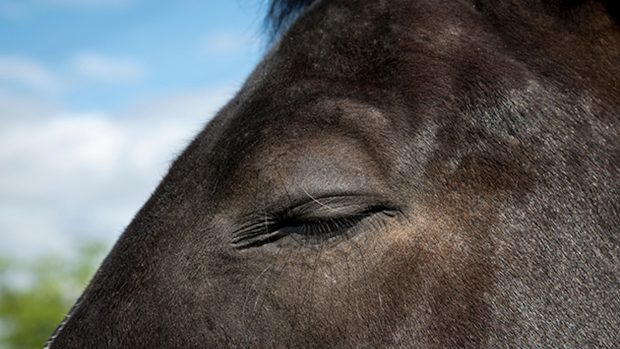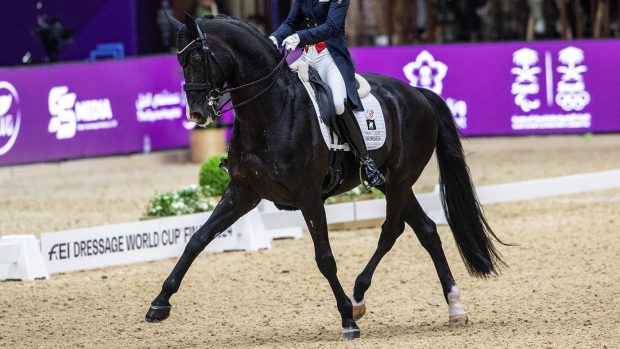Ignoring behavioural signs, indiscriminate worming, over-feeding and wound powder. It’s an unusual and not exhaustive list, but one of which a leading equine vet has a great deal of experience.
Former British Equine Veterinary Association president Lucy Grieve has named her “pet hates”, having spent a lot of time recently busting myths and helping horse owners update “some rather out-of-date knowledge”.
“Horse owners are a frequently joked-about subset of the population,” she said. “If it’s not Thelwell images, or jokes about ‘Felicity Fetlocks’, it’s the all-too-knowledgeable Pony Club instructor and well-meaning but way-off-the-mark livery yard owner. While the magic of turmeric has largely been put to bed by the Facebook militia (for once coming to our rescue), there are some rather odd habits out there among the horse-owning population that refuse to die even among my own clients, despite my best efforts.”
Ms Grieve cited a list of “ineffective and sometimes harmful” remedies, still beloved of many people, the first of which is wound powder.
“I’d like to know the basis for sticking chalk dust in an open wound would help it heal?” she asked. “I’m amazed the stuff is still being made! It’s pretty illogical to put a non-dissolvable dust into open wounds but regardless, it remains a staple of the horse owner’s first-aid kit.
“Apart from providing a visual marker of where the wound is, I can’t fathom why purple spray is still used either. Gentian violet is a dye used for histological staining, and was used long ago for its weak anti-fungal and antibacterial properties. This has thankfully been superseded by more effective and less harmful alternatives, but the memo has been missed by some.”
Ms Grieve said poulticing wounds remains popular in racing, adding: “Many a racehorse wound has been presented to me several days old and having not improved despite multiple poultice dressings, but there’s a reason for this.”
Poultices are seemingly applied to wounds to “draw the badness out”, but a look at the back of a poultice packet “reveals the reason why this is such a bad idea”.
“Poultice dressing contains some pretty harsh chemicals, such as boric acid and tragacanth, to provide osmotic draw when dressing suppurative subsolar abscesses of the hoof,” she said.
“In this instance there shouldn’t be a lot of contact, if any, between the dressing and any live soft tissues. But when placed in contact with an open wound of the skin, this is the best way to cause cauliflower-like exuberant granulation tissue which won’t heal and for which the bacteria will love you.”
Not trusting vets when it comes to horses’ dental issues is another situation Ms Grieve has frequently seen, especially from those who “never bothered rasping teeth years ago and didn’t have problems”.
“Thankfully most of the horse-owning population are on board with routine rasping and oral examination, but there are a surprising number who still seem suspicious we are making it all up,” she said.
People who think newly defined conditions are “made up”, owing to the similar “they weren’t around in my day” view, are another bugbear.
“The idea that things only come into existence once they are discovered is a concept, I still come across with horse owners,” Ms Grieve said.
“Some owners think suspensory desmitis and Cushing’s disease must be either new or ‘made up by vets to make money’, as I’ve been told by a few owners, because they weren’t around back in ‘their day’ either.”
Nutrition is a vital area of husbandry that is sometimes not kept up to date, but “some people just can’t see why they should change their grazing and feeding practices from yeara ago”, Ms Grieve said.
“Clearly equine nutrition has moved on significantly from the days where we fed ‘straights’, and grazing and roughage was considerably lower in quality and quantity. The horses were probably also less able to chew their food properly back then, for all the sharp enamel points and untreated diastemata. Never mind the worms they were sharing their calories with back in the day, and the difference in insulation provided by a jute rug back then and a 400g turnout rug with integrated neck and thermofoil-insulating lining.”
And talking of worming, Ms Grieve said there is still a “frustratingly large swathe of horse owners who have missed every memo going about worm control”.
“I have come across too many intelligent people who are still either worming every month or two with whatever pops up online first or is nearest the feed store checkout, or doing nothing at all… which is arguably better than the former,” she said. “I genuinely thought [the importance of testing for worms before treating] was common knowledge among my client base, so I had to get my nose back to the worm education grindstone.”
But Ms Grieve said her “biggest face-palming moment” is the “badly behaved” horse, who has “always done that”.
“If I was faced with that discussion by a friend at a dinner table, I would be calling a cab, but when you are attending to a horse with a client it is your duty as a vet to take up arms on this one no matter how much you fear you might lose,” she said.
“The owners who still believe their horses are naughty, bad-tempered or stubborn are some of my most rewarding interactions – when you convince them to let you investigate that horse who won’t load, or needs cross-tying to tack up, or who won’t canter on the left rein or has started refusing across country — the moment they realise it was all down to a painful condition is the most incredible experience for a vet, in my books.
“When you literally see a person’s interpretation of their animal’s behaviour completely change for the better, you know that they are going to (hopefully) meet future behavioural obstacles with a greater understanding and knowledge that will serve animal welfare no end – if not just for the animals they encounter. Your heart melts when you are called back to the same livery yard to then help a friend who is now wondering if her napping horse has pain somewhere also.
“I was brought to tears once, stemmed until I was back in the van of course!, when a 12-year-old girl followed me out to the car park to tell me how grateful she was that we found the reason for her pony’s ‘bad behaviour’, as she knew all along that hitting him and wearing spurs as her instructor had been telling her to was not the answer, but she didn’t know what was.
“I am inclined to think that due to the long-standing history between man and horse, together with the fact that many horse owners live and breathe horses from birth, or at least early childhood, many assume they must know it all by now. There is sometimes a lack of desire to ‘learn’ in a, thankfully small, portion of the horse-owning public. Most are very keen to improve their knowledge and, in fact, spend hours on social media trying.
“However, sadly for the horses of those who are sure they have it all nailed and treat new ideas or methods with suspicion, there is nothing we can do except keep trying at every opportunity we have.”
You might also be interested in:

‘They’re trying to tell us – we need to listen’: rider of ‘naughty’ horse diagnosed with kissing spine wants to help others notice signs earlier

Stark warning of more colic deaths unless owners act to avoid worming ‘Armageddon’
‘We’re on a slippery slope, and what’s at the bottom is not an appealing picture’

‘Reluctance and ignorance can mean signing horses’ death warrants’: top vet busts laminitis myths
“Food restriction is not as cruel as laminitis. Being clipped out and not wearing a rug is not as cruel

Subscribe to Horse & Hound this spring for great savings
Horse & Hound magazine, out every Thursday, is packed with all the latest news and reports, as well as interviews, specials, nostalgia, vet and training advice. Find how you can enjoy the magazine delivered to your door every week, plus options to upgrade your subscription to access our online service that brings you breaking news and reports as well as other benefits.





